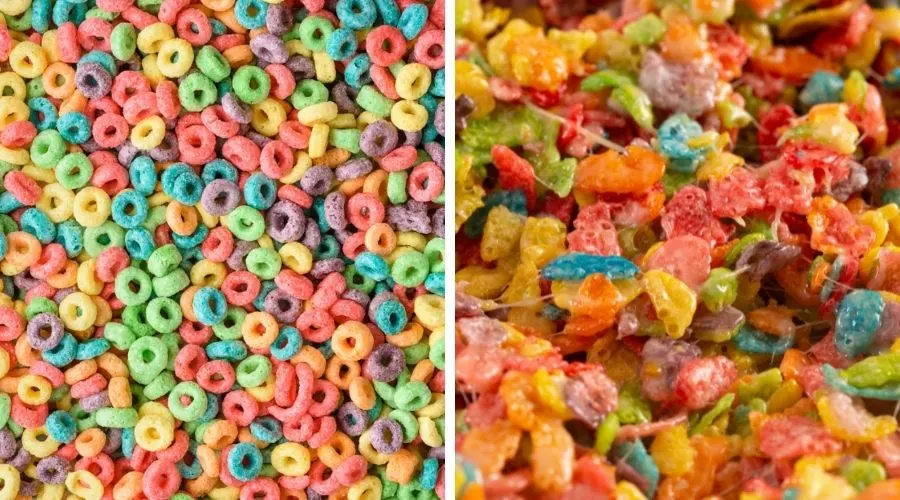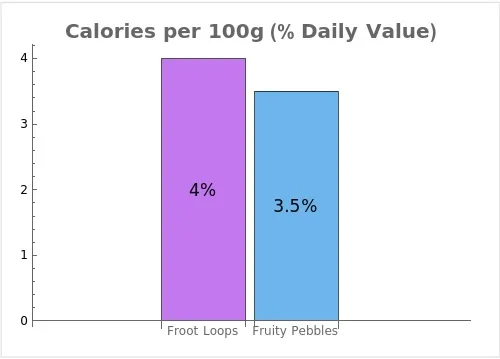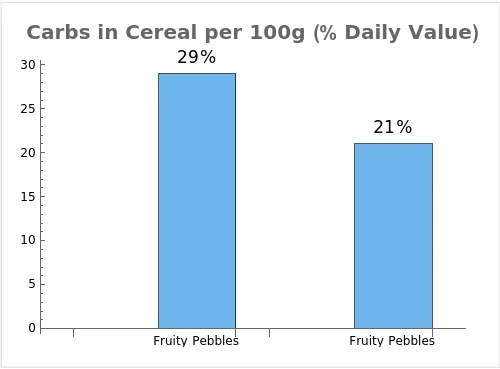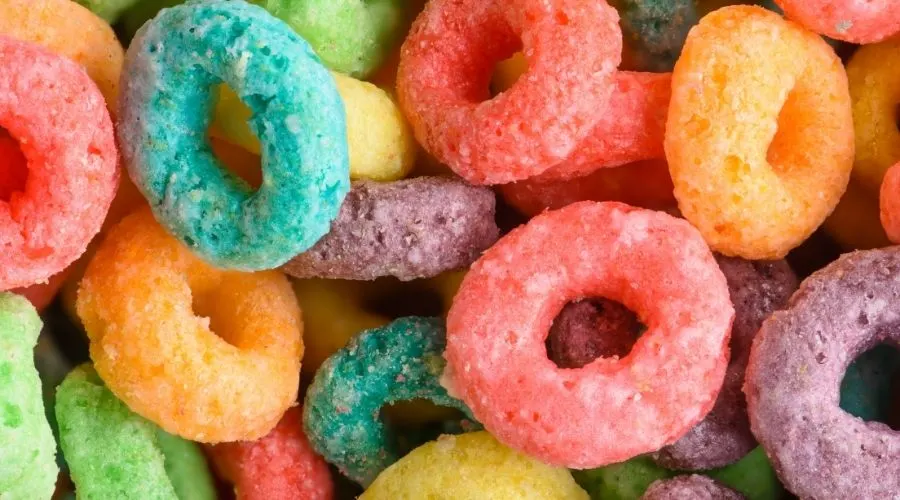Froot Loops and Fruity Pebbles are both breakfast kinds of cereal that are aimed at kids, with bright colors and fun pack cartoons that they just can’t resist.
Although we want to treat our kids, it’s only natural that we want to give them the healthiest option. But is there a more nutritious option when it comes to these cereals, and is one better than the other?
In this article, I’ll be comparing Kellogg’s Froot Loops against Fruity Pebbles head-to-head to find out which is best in various categories, including nutrition and price. Also, you can take part in our poll to tell us which is your favorite to find out which is best for flavor.
Also in This Article
In a hurry, or looking for something specific? Use the links below to jump to the relevant section:
Froot Loops Vs. Fruity Pebbles Nutritional Comparison:
Ingredients Comparision
The table below shows the ingredients for each cereal; as you can see, sugar and added colorings feature heavily in the ingredients of both Froot Loops and Fruity Pebbles.
The key difference between the two kinds of cereal is that Froot Loops are predominately made from corn-based ingredients, whereas Fruity Pebbles are a rice-based cereal.
| Kellogg’s Froot Loops Ingredients | Post Fruity Pebbles Ingredients |
| Corn flour blend (whole grain yellow corn flour, degerminated yellow corn flour), sugar, wheat flour, whole grain oat flour, modified food starch, contains 2% or less of vegetable oil (hydrogenated coconut, soybean and/or cottonseed), oat fiber, maltodextrin, salt, soluble corn fiber, natural flavor, red 40, yellow 5, blue 1, yellow 6, bht for freshness. | Rice, Sugar, Canola Oil, Salt, Natural and Artificial Flavor, Red 40, Yellow 6, Yellow 5, Turmeric Oleoresin (color), Blue 1, Blue 2, BHT, and BHA added to preserve freshness. |

Froot Loops Vs. Fruity Pebbles Nutritional Comparison
Moving onto the nutritional comparison between Kellogg’s Froot Loops and Post Fruity Pebbles.
To get the most accurate and fair comparison, we need to compare each cereal weight-for-weight, so I have made a comparison per 100g of each cereal.
I have also included data for the manufacturer-recommended serving of each cereal for information; however, it’s important to know the serving weights are not equal.
Best for Calorie Content
When it comes to calories per weight of breakfast cereal, Fruity Pebbles contain the least calories compared to Froot Loops which have 79 more calories (in kcal) per 100g.
| Cereal Type | Calories Per 100g | Calories Per Serving |
| Kellogg’s Froot Loops | 385kcal | 150kcal (Per 39g Serving) |
| Post Fruity Pebbles | 306kcal | 110kcal (Per 36g Serving) |

Best for Carbohydrate Content
Neither Froot Loops nor Fruity Pebbles are low-carbohydrate breakfast options, but if you were looking for a lower-carb option between the two, Fruity Pebbles are lower in carbs when compared to Fruit Loops.
| Cereal Type | Carbohydrates Per 100g | Carbohydrates Per Serving |
| Kellogg’s Froot Loops | 87g | 34g (Per 39g Serving) |
| Post Fruity Pebbles | 64g | 23g (Per 36g Serving) |

Best for Sugar Content
Both Froot Loops and Fruity Pebbles are relatively high in sugar compared to other breakfast cereals or other breakfast options.
Fruit Loops and Fruity Pebbles both contain 12g of sugar per serving, which is 25% of the recommended daily value, and weight-for-weight Fruity Pebbles are slightly higher in sugar per 100g.
| Cereal Type | Sugars Per 100g | Sugars Per Serving |
| Kellogg’s Froot Loops | 31g | 12g (Per 39g Serving) |
| Post Fruity Pebbles | 33g | 12g (Per 36g Serving) |
Best for Protein Content
If the protein content is important to you, Froot Loops are the better option in this category because they contain 5g of protein per 100g of cereal compared to Fruity Pebbles which have 3g.
It’s worth noting that neither cereal is a high protein option compared to other breakfast options.
| Cereal Type | Protein Per 100g | Protein Per Serving |
| Kellogg’s Froot Loops | 5g | 2g (Per 39g Serving) |
| Post Fruity Pebbles | 3g | 1g (Per 36g Serving) |
Best for Fat Content
If fat content is a consideration for you, neither type of cereal is high in fat or saturated fat, but when you compare the two, Fruity Pebbles are slightly lower in fat than Froot Loops.
| Cereal Type | Fat Per Serving | Saturated Fat per Serving |
| Kellogg’s Froot Loops (Per 39g Serving) | 1.5g | 0.5g |
| Post Fruity Pebbles (Per 36g Serving) | 1g | 0g |
Cholesterol
When it comes to cholesterol, neither Froot Loops nor Fruity Pebbles contain any cholesterol per serving.
Best for Fiber Content
Fiber is often an important consideration to consumers choosing a breakfast cereal, and it’s important to note that when it comes to Froot Loops and Fruity Pebbles, neither kind of cereal is a high-fiber breakfast choice.
When comparing the two breakfast kinds of cereal, Froot Loops is the better option for fiber content because Fruity Pebbles don’t contain any fiber compared to Froot Loops which have 2g per serving.
| Cereal Type | Dietary Fibre Per 100g | Dietary Fibre per Serving |
| Kellogg’s Froot Loops | 5g | 2g (Per 39g Serving) |
| Post Fruity Pebbles | 0g | 0g (Per 36g Serving) |

Best for Sodium/Salt Content
Froot Loops and Fruity Pebbles have a very similar sodium content, but when comparing the two, Froot Loops contain slightly more per weight (although this is a nominal amount).
To put this into the context of a recommended daily value, Froot Loops contain 9% of the daily value of sodium, compared to Fruity Pebbles which have 8%.
| Cereal Type | Sodium/Salt Per 100g | Sodium/Salt per Serving |
| Kellogg’s Froot Loops | 538mg | 210mg (Per 39g Serving) |
| Post Fruity Pebbles | 528mg | 190mg (Per 36g Serving) |
Best for Vitamins/Minerals
Both Froot Loops and Fruity Pebbles are fortified breakfast cereals which means they’re fortified with vitamins and minerals to help consumers get towards their recommended daily values of various nutrients.
Of the two, Fruity Pebbles are fortified with higher levels of vitamins and minerals in more categories per serving; take a look at the table below to see the comparison between the two:
| Vitamin/Mineral Type | Kellogg’s Froot Loops Daily Value % Per Serving | Post Fruity Pebbles Daily Value % Per Serving |
| Vitamin A | 10% | 10% |
| Vitamin C | 25% | 10% |
| Calcium | 0% | 0% |
| Potassium | 0% | 0% |
| Iron | 25% | 6% |
| Vitamin D | 10% | 10% |
| Thiamin | 20% | 35% |
| Riboflavin | 20% | 40% |
| Niacin | 25% | 40% |
| Vitamin B6 | 20% | 25% |
| Folic Acid | 20% | 60% |
| Vitamin B12 | 20% | 80% |
| Zinc | 10% | 15% |
Best for Flavor/Texture
To find out which cereal is the best for taste, we need to get an opinion over a broad demographic of people.
You can help future readers and us by voting for your favorite in the poll below, and once you vote, you’ll be able to see the winner so far.
Best for Price
At the time of writing this article, a box of Froot Loops which weighs 19.4oz, costs an average of $3.64 ($0.19 per ounce) and a 28oz box costs $4.98 (0.18 per ounce).
A box 20.4oz box of Fruity Pebbles costs an average of $3.98 ($0.20 per ounce), and a 27.5oz box costs an average of $4.98 ($0.18 per ounce).
Based on these figures, Froot Loops cost slightly less per weight on average, although costs are very similar between the two.
Overall Winner
All categories have now been compared, and I can now announce a winner of the best in most categories between Kellogg’s Fruit Loops and Post Fruity Pebbles, and the winner is – Fruity Pebbles.
This was a very close contest, but Fruity Pebbles won the most categories, including Best for calories, carbs, fat, sodium, and vitamins and minerals.
Froot Loops came in best for sugar, fiber, protein, and price, although it’s important to note that there wasn’t much difference between these two in most categories.
Neither cereal is the healthiest compared to other options available, such as high-fiber low-sugar bran, or whole-grain cereals.
You can use this information to decide which is best for you based on your needs and diet requirements.
| Comparison Category | Winner (Froot Loops or Fruity Pebbles) |
| Best for Calorie Content | Fruity Pebbles |
| Best for Carbohydrate Content | Fruity Pebbles |
| Best for Sugar Content | Fruit Loops |
| Best for Protein Content | Fruit Loops |
| Best for Fat Content | Fruity Pebbles |
| Best for Fiber Content | Fruit Loops |
| Best for Sodium Content | Fruity Pebbles |
| Best for Vitamins/Minerals | Fruity Pebbles |
| Best for Price | Fruit Loops |
| Overall Winner | Fruity Pebbles |
More Froot Loop & Fruity Pebbles FAQ’s
The correct spelling of the popular Kellogg’s cereal brand is ‘Froot’ Loops and not Fruit Loops.
No, Froot Loops and Fruity Pebbles have different ingredients, with the main difference being that Froot Loops are made from a blend of corn flour, compared to Fruity Pebbles whose main ingredient is rice.
Related Articles
I hope this article has helped you to find the information you were looking for; you might also find the following articles helpful too:
Corn Flakes Vs. Frosted Flakes (Which is Best?)
Cheerios Vs. Honey Nut Cheerios (Which is Best?)
Chicken Nuggets Vs. Plant-Based Nuggets
References Used for this Article
To ensure the nutritional information used in this article is accurate, I have used data from Smart Label and Post; the links below contain the source information:
